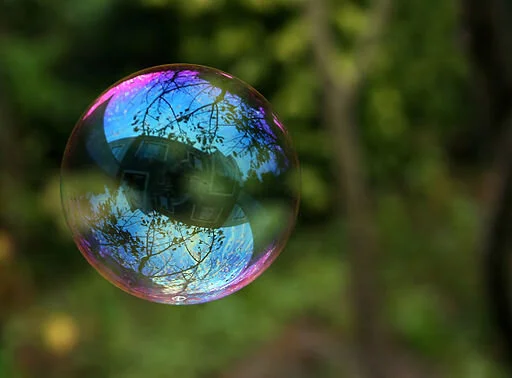How to Beef Up Bubble Solution
Chemical science in the Kitchen: Make Your Ain Bubbles With Dish Lather
/Everyone loves bubbles. They're a favorite outdoor activeness on a dainty sunny twenty-four hours. We tin chase them, run through clusters of them, and popular them. They flash with beautiful rainbow colors. Bubbling are great!

Image Credit: Eduard / Istock / Getty Images
Nosotros take provided a great bubble recipe down below that involves 1 of the most mutual items in a kitchen: dish soap! Only first, did y'all ever wonder what'due south the scientific discipline behind bubbles? What actually makes up a chimera? Why are they round? Why practice they popular? What are the pretty rainbow colors? Let's explore these questions.
What makes upward a bubble?
Bubbling are made up of two things: lather and water. You can remember of a bubble as a sandwich of sorts. The two pieces of "bread" consist of soap molecules (a grouping of atoms bonded together). The "meat" of the sandwich is a sparse layer of water. The soap keeps the water safe and sound; for a while at to the lowest degree. Of course nosotros tin't forget that the entire chimera sandwich encloses air.

A single soap chimera displaying the 3 layers that make upwardly the "chimera sandwich"- soap on the meridian and bottom, and h2o in the middle. (Image credit: Pashminu, Wikimedia Commons)
Why are bubbling always round?
Let's say your bubble wand is shaped like a heart or star. When you create a bubble with your wand, information technology may stretch, only when you seal the bubble, information technology will not be shaped like a heart or star, just a round shape chosen a sphere. No matter what, a single bubble will e'er endeavour to go a sphere. This is because the sphere is the smallest possible shape for the volume of air it contains. If a bubble had corners or edges, the soap would be stretched unevenly, and therefore would exist less efficient because it requires more energy to achieve.

Single bubbles volition always be a sphere shape. (Image credit: Brocken Inaglory, Wikimedia Eatables)
Why exercise bubbles pop?
In that location are a few reasons why bubbles pop. The likely culprits are:
-
Water evaporation
-
Strong winds
-
Dryness.
The sun plays a major office in evaporation as information technology changes water from a liquid to a gas or vapor. This causes bubbles to pop. Along with evaporation, air current is another chimera popper. Stiff winds and sometimes gentle breezes can destroy a perfectly good bubble or fifty-fifty prevent bubbling from forming. Dry conditions are also a reason for bubbles popping. If the air, or any surface, similar your finger, is dry, bubbles don't stand a chance and will instantly pop.
Here are some ways to create the perfect atmospheric condition for bubbling:
-
Stay in the shade if possible
-
Endeavor blowing bubbles right after the sun sets
-
Exercise not accident bubbles when it is windy out
-
Right after a rainstorm is a good time to play with bubbles considering the air is full of moisture
-
Accident your bubbles in a broad open space and then they will less likely run into dry out objects
-
Keep bubble tools (or hands) moisture so your bubbling don't accidentally popular

What causes the rainbow colors to form on bubbles?
The beautiful collection of colors that you run into on a bubble are lite waves reflecting back to your eyes from the outer and inner soap layers. The low-cal waves from the two layers interfere with each other. The interference can cause certain colors to appear dull or non-existent, while other colors announced more vibrant. The colors that you lot see in a bubble are called interference colors and what you see depends on the thickness (which constantly changes) of the soap and water layers. Because the layers constantly change, the colors constantly change, and no 2 bubbling will have the same color arrangement.
The Perfect Bubble Recipe
Now that yous know a petty science backside bubbles, y'all tin can hands make your own! The following recipe is merely one fashion to make bubbles.
Materials:
-
3 cups of water (distilled is best if y'all have some)
-
i cup of liquid dish soap (Dawn or Joy brands work best)
-
½ cup of white corn syrup OR ½ loving cup of glycerin (these ingredients will slow down water evaporation and help build stronger bubbles)
-
A container to go on your bubble solution in
Instructions:
-
Cascade the h2o into your container
-
Add the glycerin or corn syrup to the container and stir
-
Advisedly cascade and gently stir the dish lather into the container
-
For best results, let the bubble solution sit down overnight
-
You are now ready to blow some bubbles! Grab your bubble wands and get outside!
Want More Bubble Science?
To proceeds an even deeper agreement behind the science of bubbles, click here to join Physicist Dr. Helen Czerski equally she takes you on a bubble-filled journeying in the documentary: "The Science of Bubbles".
Past Megan Goldsmith
Source: https://www.starhop.com/blog/2020/7/7/chemistry-in-the-kitchen-make-your-own-bubbles-with-dish-soap
0 Response to "How to Beef Up Bubble Solution"
Post a Comment